We recently caught up with longtime Guitar Tricks instructor Anders Mouridsen, who is on the road with the rising Country star Cam. Anders shares with us details of their journey, the hard work and unpredicted technical issues that may arise when playing live. Their journey is comprised of many memorable experiences and triumph.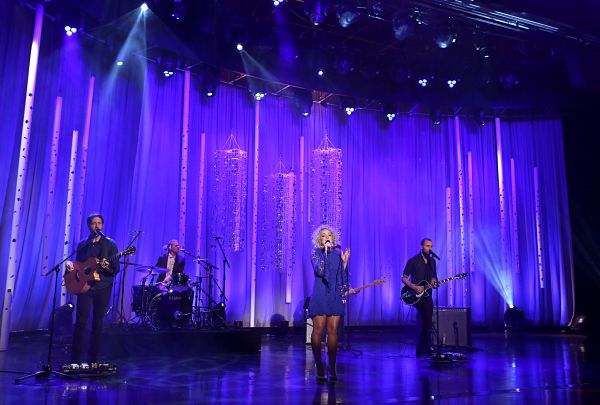
I think I could write a novel about everything I've learned and experienced since the beginning of this year -- and I could probably write a trilogy about last year alone. But for the sake of keeping the format short and sweet, let me condense this part: I met a phenomenal singer named Cam, and with a small group of friends we started writing and recording songs together. Soon after that, she got signed to a major record label, and we spent all of 2015 meeting with and playing for almost every country-radio DJ in the country, as well as opening up for almost anyone with a name in the country music world. It was a lot of rigorous travel, hard work and hustle for very little artistic payoff. But we were all happy to do it, especially because we could see the progress every day. More and more people were singing along at shows; friends would hear the songs on the radio and Cam would get recognized in public more and more.
Now let's skip ahead to the part where things started to get really fun, starting back at the beginning of this year. Cam's song “Burning House” had just gone #1 in country radio, and had sold over a million copies. The first gig of 2016 was on live TV on The Tonight Show with Jimmy Fallon. We had played on The Today Show at the end of 2015, but this felt like a whole new level. All my friends and family back in Denmark would be able to see this, and you just get one take to get it right. If something goes horribly wrong, you can technically inconvenience everybody (not to mention cost the network a fortune) and record another take after the rest of the show is done. But by then the pressure would be even heavier, so it is extremely important to nail it the first time! This is not a regular live-performance where it's there and then it's gone – You'll have to live with this performance afterward, and it'll replay again and again in Cyberspace and sometimes even on the network.
For all of these reasons, many bands incorporate various amounts of pre-recorded tracks. Some play and sing along to the tracks, so the performance is partially live. Some only sing live, and others don't even do that. We do it all live, which is fun, but also incredibly nerve-wracking. Burning House is a tender ballad with a long and tough guitar intro, delicate backing vocals, brushes on the drums and every detail exposed.
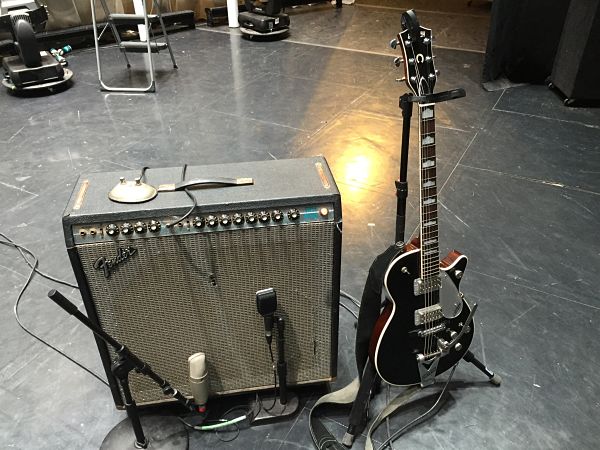
We arrived at the studio early in the morning, and it's always quite a procedure getting into the building with heavy security and lots of formalities. From there we went more or less straight to the stage, where there was a rented backline already set up for us. I had flown in straight from Christmas vacation in Denmark, and the rest of the band had come in from L.A. and Nashville, so there was no way to bring our own drums or amps. They had a decent new Super Reverb for me to play, and it sounded fine. It wasn't as nice as the old Silver Faces I normally use, but I knew it would get the job done. We use in-ear monitors for these kinds of performances, instead of the traditional floor monitors. This means you wear a pair of isolating ear buds that are plugged into a wireless receiver. Each player has his/her own mix, making it possible to pan instruments and vocals left and right, add reverb, etc. With the right mix, you're able to hear every little detail, but it's also fragile if anything goes wrong, because you can't hear the acoustic sound of the instruments in the room. It can also sound and feel very unnatural sometimes if the monitor engineer isn't really good at his job. Fortunately, this guy was on it, and it already sounded good as soon as we started playing. Then we made a couple of little tweaks and started to get comfortable with the room and the sound.
After that, it was a whole lot of waiting around backstage. There was a presidential candidate on the show that night, so Secret Service guys were everywhere. We mostly hung out in our vibey little backstage room which had a piano and a bunch of other instruments, and I walked the hallways and practiced. After what felt like an eternity, I realized that it was getting close to showtime. I usually have a quiet moment in the bathroom, where I stare calmly into the mirror and take some deep breaths. Again, remember that these three and a half minutes of music will go out to millions of people all over the world, the label has spent a fortune getting everybody there and the future of the project you've dedicated yourself to relies heavily on this performance. You'd have to be some kind of robot to not be really really nervous! I've had monitor mixes all of a sudden be completely different from how they were during sound check. I'd had rental amps crackle and pop and a whole host of other issues happen completely outside of my control. I keep my gear and instruments well maintained, but even then stuff can go wrong. For example - the day after we played live on Ellen Degeneres, two power cables in my professionally-wired pedalboard just gave out. It just happens sometimes. So even if you trust your playing, you have more than enough reasons to be nervous.
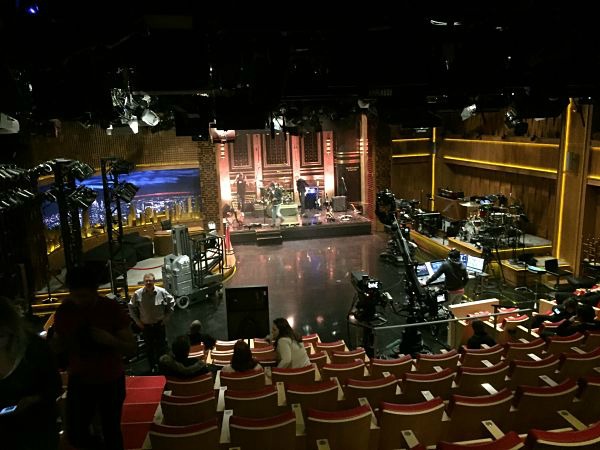
When we finally go out there, The Roots are sitting right there, six feet away, staring at us. They're all incredibly friendly and supportive, but just their presence alone is enough to put you even more on edge. Then there is the floor before you, which is full of all kinds of cameras and cranes. To your right is where Jimmy has his interviews and from where he would introduce us. The audience is way in the back, so you can't really connect with them. Otherwise, that really helps. When we played on Kimmel we performed on a regular, small stage with an actual crowd. This helps you forget about the cameras and just get lost in the music. But not here! The Roots on your left side, Jimmy on your right and an army of camera-robots in front of you.
Now we're walking on stage and we have a few minutes to make sure everything is good to go before we're introduced. As soon as I plug into the amp, I hear this nasty, high-frequency buzz. This wouldn't be an issue if we were playing a loud rock song, but I'm using the full dynamic range for this song, so this buzz needs to disappear. The stage guys rush over and try to pin it on me: “You'll just have to go through your cables one by one and see where the issue is." Now this is where I'm thankful to have a lot of experience. First of all, I know my gear is in good shape, but I also know what it sounds like when it isn't. And this isn't that. The buzz wasn't there for the sound check, so I figure it must have to do with the lights they added since then. And sure enough, it turns out there is a powerful light right behind my amp, and as soon as the stage hands realize this, they start moving stuff around until the buzz is almost gone. All of a sudden I hear Jimmy go, “Ladies and gentlemen, Cam!” and we're on. Fellow GT instructor Douglas Showalter starts playing the intro. This intro is a beast to play and completely exposed, but Doug has done a great job playing this part under intense pressure. I've spent so much of the pre-performance time moving lights around and listening for the buzz that I feel I still need to check my tuning. This means I have to tune while the intro is playing. I figure the camera will be on Doug anyway, but no, of course, it pans to me, and everyone can see me tuning. At this point, I have no idea what my name is or where I am. It all feels a lot like a dream. Fortunately, my fingers and my vocal chords know what to do. They take over and we play the song beautifully.
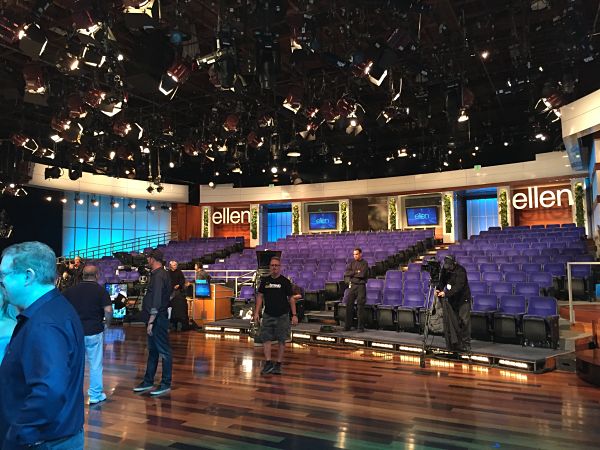 I still occasionally feel the kind of nerves where your fingers feel like they aren't working like they should, but most often I'm in this dream-like state when I'm really nervous. Maybe it wouldn't happen if I didn't know the song as well as I do, or if I was struggling with my sound. In a sense, it is possible that this is one of the ultimate states of performing: when it feels surreal like you're floating in time. That's not to belittle how special it can be when you're completely present and just communicating in a fun way with your instruments. I love that too, but this kind of dreamy state is much rarer.
I still occasionally feel the kind of nerves where your fingers feel like they aren't working like they should, but most often I'm in this dream-like state when I'm really nervous. Maybe it wouldn't happen if I didn't know the song as well as I do, or if I was struggling with my sound. In a sense, it is possible that this is one of the ultimate states of performing: when it feels surreal like you're floating in time. That's not to belittle how special it can be when you're completely present and just communicating in a fun way with your instruments. I love that too, but this kind of dreamy state is much rarer.
We play the last note and everyone applauds - that's when I kind of slip back into reality. I know I didn't hear any clams (that would have pulled me out of the Zen-like state), so I assume it was a solid performance. But in reality, you don't know until you've watched it. Until you can find it on the internet, you find yourself in a kind of post-performance limbo. I'm sure this isn't the case for musicians who've played on TV a million times, but the first many times I did, it was the case. You're left with the relief of having it be over with, without experiencing any major disasters, but also the anxiety of not yet knowing exactly how the performance sounds.
After that, we hung around the studio for a bit. Our drummer Walle Wahlgren got to spend a little time with Questlove, and see the tiny office-like space where he has recorded many of the drums for The Roots' records. Walle has been a fan of his for a long time, so this was huge. The rest of us got to hang out with Jimmy in the hallway, and in person, he is just like he is on TV: super funny, friendly and positive. You can see how he's a good interviewer and entertainer because he instantly makes you feel comfortable in his presence. He really enjoyed the performance, so that's the first good sign I see, and it eases my post-performance anxiety a little bit. We're all trying to get a reservation at a nice restaurant to celebrate, but there are nine of us and it's a Saturday night in NYC, so it's virtually impossible. Fortunately, Jimmy hooks it up, and we're off to an extraordinary night at a restaurant with VIP treatment.
That night in the hotel room our bass player, Alex Balderston, and I stayed up to watch the performance as it aired. Initially, we both felt like the tempo was way too fast, but this was most likely our nerves making us think that. The next morning, we wake up, watch it again and I could swear it was a slower tempo than the night before. That's the power of nervous energy.
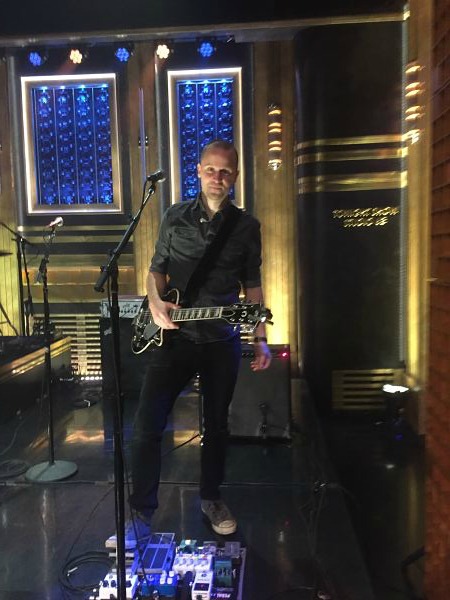 Today I'm very proud of that performance, the song and Cam's career in general. We've done many high-profile TV appearances since then, and while the nerves remain, you learn to trust that it'll all work out one way or another. I've also learned that there's no level where technical things don't go wrong. Take Adele's performance at The Grammy's, where the grand piano's mic fell and landed on the piano strings, or Ed Sheeran's solo performance at a sold-out Wembley, where his looper went out and they somehow didn't have a backup. Not to mention Megan Trainor's fall on the Tonight Show. I could go on and on. Stuff goes wrong, and you just learn to improvise. Most often the audience never finds out, and in the rare case where they do, they may even appreciate it. At least they'll know that it's live.
Today I'm very proud of that performance, the song and Cam's career in general. We've done many high-profile TV appearances since then, and while the nerves remain, you learn to trust that it'll all work out one way or another. I've also learned that there's no level where technical things don't go wrong. Take Adele's performance at The Grammy's, where the grand piano's mic fell and landed on the piano strings, or Ed Sheeran's solo performance at a sold-out Wembley, where his looper went out and they somehow didn't have a backup. Not to mention Megan Trainor's fall on the Tonight Show. I could go on and on. Stuff goes wrong, and you just learn to improvise. Most often the audience never finds out, and in the rare case where they do, they may even appreciate it. At least they'll know that it's live.
One of my favorite guitar teachers, Per Mjoback, taught me early on to appreciate the nerves, and I hope they never go away. How they manifest themselves and how I use them is going to change, but the day they actually disappear, that's when I'll be really nervous.